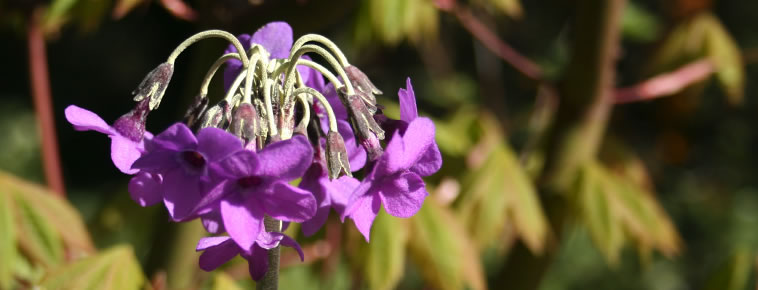
THE HISTORY OF CLUNY
Cluny House is a large stone-built mansion facing north-east and overlooking the Strathtay valley in Highland Perthshire. The oldest part of the house dates back to the early 1800s. A large extension was completed in 1880 by the Scottish architect James MacLaren, and the original house was renovated in keeping with the new extension. The house was designed as a shooting lodge and in the first half of the 20th century was lived in mainly during the shooting season. When the house was full of guests and servants, it was reputed that a ton of coal was burnt each week.During the Second World War the house was occupied by evacuees from Glasgow but remained empty until 1949 when Bobby and Betty Masterton bought Cluny along with 9˝ acres (4ha) of ground. Bobby was the local Veterinary Surgeon but he had a passion for growing plants from seed particularly those from the Himalayas and the woodlands of North America. He knew they would thrive at Cluny with its favourable soil conditions, aspect and climate which would allow him to create a very special woodland garden.
There were existing mature trees on the property including an Abies alba, the European Fir, probably the oldest tree in the garden at about 200 years old, a Fagus sylvatica ‘Asplenifolia’ the fern-leaved beech, and a Juglans regia, the walnut, which is now completely hollow. However, the most impressive of the old trees are two excellent specimens of Sequoiadendron giganteum, Wellingtonias or giant redwoods, planted in the 1860s, one of which is reputed to be the widest conifer in the UK. There was a well-laid out lawn with a large gravel area in front of the house but throughout the remainder of the garden, brambles and nettles were the dominant ground cover.
The garden area was fenced against deer and rabbits and a shelter belt of fast growing conifers and poplars was planted to protect against the north and north-easterly winds. Bobby received 400 packets of seeds direct from the 1949 Ludlow and Sherriff expedition to Bhutan which allowed him to germinate and grow rare and unusual plants, their progeny and even some of the original plants remain in the garden today. He made many contacts in horticultural circles throughout the UK from whom he exchanged or bought seed and plants.
The garden was planted up with an enormous variety of trees and shrubs including numerous varieties of Japanese maples, birches, rowans and hundreds of rhododendrons. Thousands of bulbs were planted from common daffodils and snowdrops to scarcer trilliums and nomocharis, and dotted amongst them were hundreds of primulas and meconopsis.
Eventually, the garden was recognised as something rather unique and amateur and professional horticulturalists came from all over to appreciate Cluny for themselves. The garden was first opened regularly to the public in 1975 under Scotland’s Gardens Scheme, a charity organisation.
Sadly only a few years after retiring early to devote more time to the garden, Betty Masterton died in 1985 and Bobby shortly afterwards in 1986. In 1987, Wendy, their youngest daughter, and her husband John Mattingley took over the management of 6 acres (2.4ha) of the original garden. John had a very keen interest in Cluny since first seeing it in 1974. He had learned a great deal from Bobby Masterton and acquired his enthusiasm for woodland plants in general and Asiatic primulas, lilies and arisaemas in particular. The Mattingleys have continued to run the garden with a similar approach to the Mastertons but on organic principles without the use of pesticides or herbicides.
